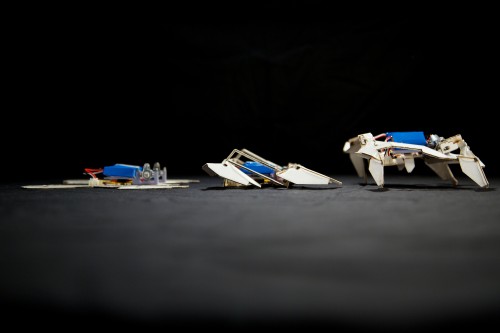
Ready, steady, go: a profile view of the “transformer” robot. (Courtesy: Seth Kroll, Wyss Institute)
By Tushna Commissariat and Michael Banks
While the latest Transformers film hit cinemas in the UK earlier this month, scientists in the US at Harvard University, along with colleagues at the Massachusetts Institute of Technology, have developed the very first “real life” transformer: a robot that starts out flat, folds and assembles itself into a complex shape and can then crawl away – all without any human intervention. Indeed, these printed robots can self-fold themselves in about four minutes – a huge improvement on previous models that could take up to two hours. They can even turn and naviagte around, making them a handy and practical tool.
The robots were actually fabricated using origami – the ancient Japanese art where a flat sheet of paper is folded into complex 3D shapes. Lead authors Sam Felton and Robert Wood from Harvard, along with the team, used a clear, shape-memory polymer that is lined with mechanically pre-programmed hinges that are designed to contract at 100 °C. The folding process was automated by adapting software for origami design to generated the specific crease patterns need for the polymer. The robots could have many applications even in its current form, as they are compact and can be transported flat. Take a look at this video of the robot assembling itself and watch it scuttle away.
In other news, you can now send the remains of your cherished pets into space. That’s right, Celestis – the firm behind sending the remains of loved ones into space – has branched out with Celestis Pets, where you can send 1 g of the cremated remains of your dog or cat – or a “lock of its hair” – out into the cosmos. The cheapest package is “Earth Rise”, which will set you back $995 and involves the remains being blasted into the atmosphere and then returning safely to Earth. For $4995, “Earth Orbit” lets your pet orbit Earth before “harmlessly vaporizing” in the atmosphere upon re-entry. But for those really wanting to go that extra mile, $12,500 sends your domesticated friend to the Moon or even into interstellar space through the “Voyager” bundle. “The service provides your beloved pet with an incredible journey through the stars, allowing them to explore places they could have only dreamed of in life,” says the firm on its website. And what do you get in return? A certificate confirming that your pet did indeed go into space. Well worth the expense, then.
And in other weekend amusement, take a look at this Veritasium video looking at five fun physics phenomena, watch the trailer for Stephen Hawking’s biopic – The Theory of Everything – and take a look at the BuzzFeed list of the 25 problems that PhD students face, beyond their thesis.
Trackback: Physics Viewpoint | Rise of the real transformers, a celestial farewell for your furry friend and more
Trackback: Blog - physicsworld.com